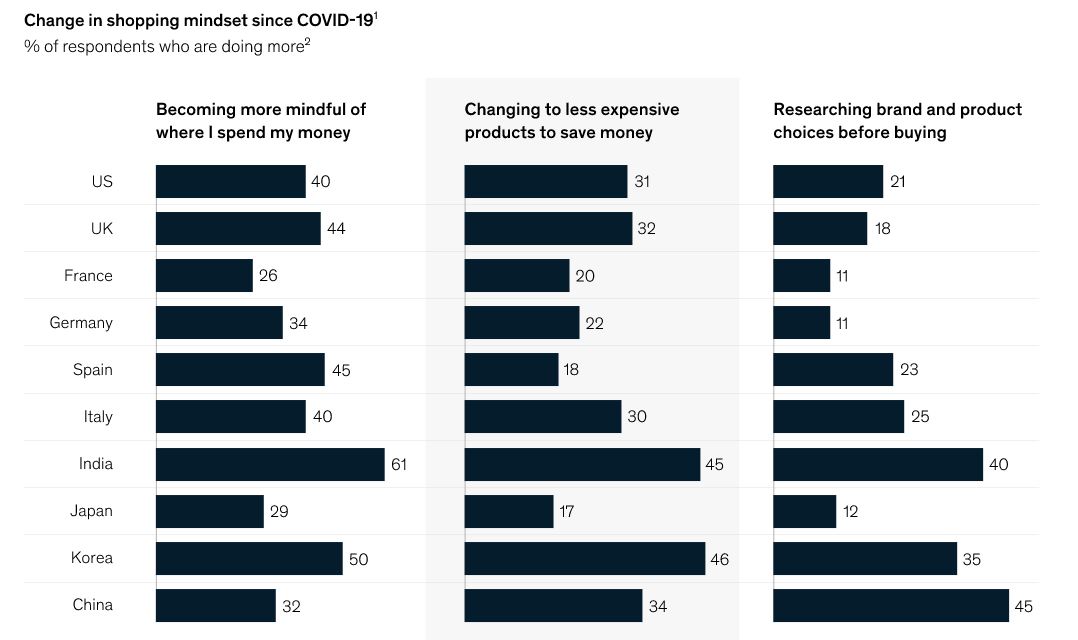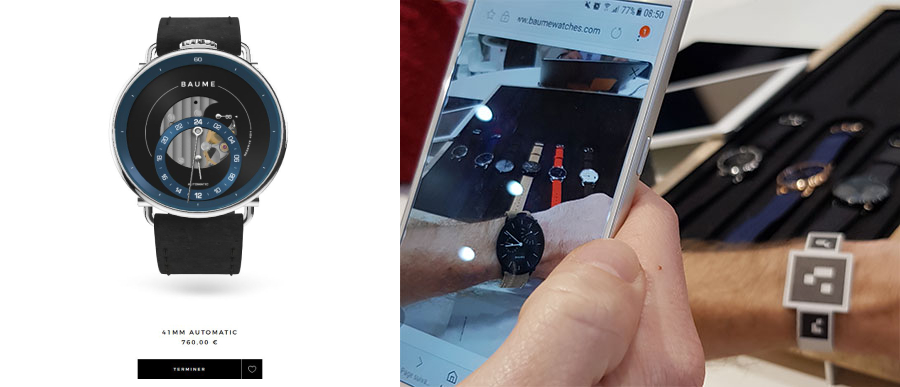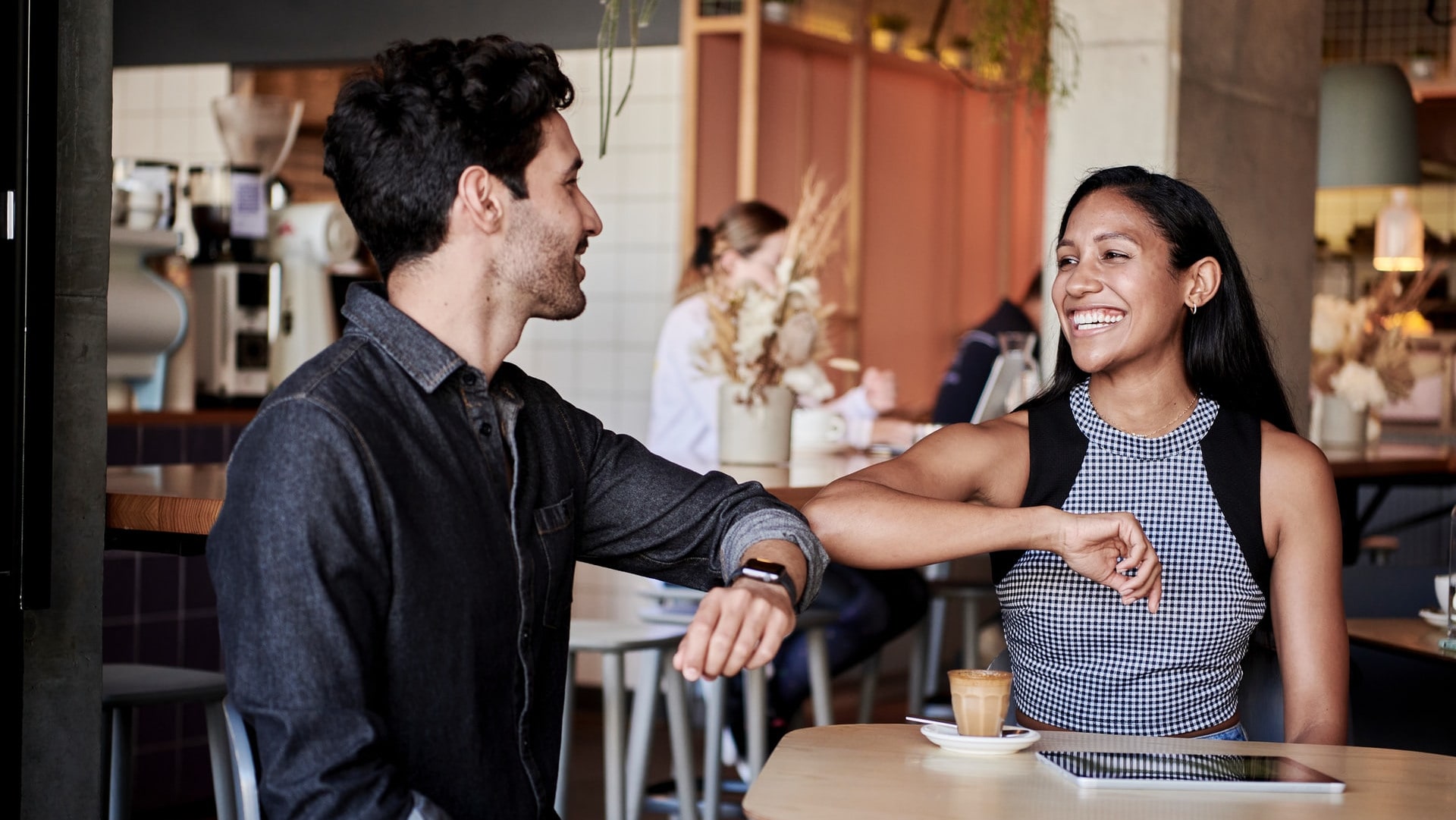Changing consumer behaviors during coronavirus: 6 consumer trends and 1 to-do list
By Yahong Zhang |Table of contents
Even before the COVID-19 crisis, luxury brands were adopting new channels and tools to satisfy their ever-changing luxury consumers, who are becoming younger, more oriented towards a memorable shopping experience and in a constant quest for products that respect their unique values.
And then the pandemic takes place with a series of repercussions, which is not only impacting our incomes and financial stability but also changing consumer behaviors and shopping patterns.
Changing consumer behaviors: 6 trends
1. Consumers are being more mindful about their spending
According to McKinsey, consumers worldwide have seen a decrease in incomes and savings. In May, 73% of Brazilians, 70% of Indians, 54% of Chinese, 51% of Italians, 45% of Koreans, 42% of British, 38% of Americans and 38% of French respondents confirmed that their incomes reduced due to the COVID-19 crisis.
While about 15% to 25% of respondents in Italy, UK, the Unites States and France tend be positive about a quick economic recovery, 75% to 85% of them remaining mixed or pessimistic and believing that the economy will be impacted for 6 to 12 months or even longer, Chinese and Indians have a more positive outlook. In China and India, over 50% agree that the economy will rebound in 2-3 months while the other half of them are mixed or pessimistic.
Japanese are the most pessimistic about the financial recovery, where 95% of respondent are unsure or pessimistic about the rebound and 35% of respondents think that the coronavirus crisis might cause a recession.
With many people expecting COVID-19 to negatively affect their finances as well as their daily routines for at least another four months, consumers are being mindful about their spending and trading down to less expensive products.

Consumer sentiment and behavior continue to reflect the uncertainty of the COVID-19 by Mckinsey.
Leading this shift to mindful shopping, are Indians, Koreans and Chinese: 61% of Indians are becoming more mindful of where they spend the money (the highest proportion) compared to 26 of French (the lowest proportion), 46% of Koreans are changing to less expensive products to save money compared to 17 of Japanese, and 45% of Chinese are researching brands and products choices before buying compared to 11% of French and Germans.
According to the same report, consumers in China, India, and Korea are reporting positive spending intent on a broad range of categories, including food takeout and delivery, snacks, skin care and makeup, non-food child products, fitness and wellness, and gasoline.
2. Consumers are going digital and omni-channel and their expectations are changing
According to McKinsey, more consumers expect to shop online across many categories and such a habit is here to stay even after the COVID-19 crisis.
In essentials and home-entertainment categories, online shopping increased by over 35% and even in discretionary categories such as skin care and makeup, apparel, and jewelry and accessories, reports show expected customer growth of more than 15%. In the US alone, consumers vaulted 10 years in the adoption of digital tools in just 90 days.
In countries that already has a much higher affinity for online shopping before the pandemic, as is the case of China, although the actual percentage of online shoppers could not go much up, the overall order values increased.
Moreover, while free and fast delivery remained of top importance, consumers are paying attention to other criteria too, such as informative product descriptions, high quality images and fast website loading.
Indeed, in a period when consumers spent most of the time online, demands to enjoy better digital experiences skyrocketed, as they became less tolerant of unresponsive channels.
Moreover, since shopping without getting the actual look and feel becomes the norm, consumers expect brands to put in extra effort to offer an accurate view of products, that would compensate for the fact that they couldn’t test and try out.
3. Consumers are actively trying new brands and products, which presents great business opportunities
For example, 82% of Chinese consumers and 75% of American consumers confirmed that they have tried a new shopping behavior, be it a new brand or a new shopping channel, and over 60% of them mentioned that they will stick to this development.
4. Outbound shopping experienced significant reductions, which brings attention back to domestic markets
Luxury shopping and outbound travel are significantly related, because 20-30% of revenues in the luxury business are driven by travellers who purchase outside of their countries of residence.
Since 2013, China has been the largest country for outbound departures, with the highest number of tourists. For example, in 2017 China had 143,035,000 international departures, which is 63% more than that of the U.S.A. And in 2019, the number grew by 17% and exceeded the 174 million threshold. As McKinsey estimates, in 2018 the purchases made by Chinese travellers abroad accounted for more than half of the country’s luxury spending.
On a worldwide level, outbound luxury shopping becomes a frequent practice for several reasons: consumers enjoy lower prices, limited editions and a sense of authenticity.
With outbound travel reduced considerably due to the global pandemic, Chinese shoppers as well as consumers everywhere will direct higher budgets in domestic markets in a new fashion, which brings both opportunities and challenges.
5. Consumers prefer to resume activities at home
Although measures have been taken around the world to ensure safety, over 70% of populations still don’t feel comfortable resuming their day-to-day activities outside of their sweet homes. This means that for marketers it is great time now to seize the day and invest in digital marketing tools for better sales results.
6. A new desire for “the ownership of things” rather than “the luxury experience”
In the past years, Millennials have redefined the luxury business and shifted the trend from “the ownership of things” to “the luxury experience”. Indeed, as demands for social media worthy moments increased, consumers themselves have turned into a key opinion leader and are always eager to have an unique and memorable experience to share with their own communities instead of simply a bag or a piece of jewelry.
However, with social distancing becoming the norm, consumers are now temporarily return to this ancient appreciation for simply purchasing and enjoying products, as well as associated values and attributes. This means that greater attention will be paid to the quality, design of products themselves.
How can brands respond to the shifts in consumer behaviors?
1. Digitalization and an outstanding digital customer experience
Digitalization is described by Gartner as “the use of digital technologies to change a business model and provide new revenue and value-producing opportunities; it is the process of moving to a digital business.”
Companies are embracing Digital Transformation due to static traditional approaches
For the past decades, businesses have been evolving towards digitalization and trying to shift into a more technological approach that adopts digital tools in everyday tasks, at both individual and organizational levels, to have more accessible and transparent data, faster processes and higher productivity.
As TechPro Research shows, 70% of companies either have a digital transformation strategy in place or are working on one, while the IDG Digital Business research showes that 44% of organizations had fully adopted a digital-first business approach.
In a word, digital technology investment will grow across all sectors, ranging between 15% and 20%, while the overall digital transformation spending was already over $1 trillion in 2018, according to International Data Corporation forecasts.
Customers have shown increasing interests in digital experiences and online content too.
Actually, the ability to satisfy consumers’ consistently developing new shopping patterns and demands is another reason why digitalization is extremely important for businesses.
According to the report Digital 2020 by WeareSocial and Hootsuite, more than 4.54 billion people (around 60% of the Globe’s population) are currently online, while 5.19 billion use mobile phones. Just in 2019, 298 million people mainly from developing economies, have joined the world wide web.
The average internet user now spends 6 hours and 43 minutes online each day, browsing websites, social media, apps, enjoying the benefits of online shopping and streaming services and so on.
During the quarantine too, digital consumption may increase to 60% or more, according to Nielsen research. Even in Hong Kong, which is mostly a brick-and-mortar market, consumers quickly adjusted and downloaded e-commerce apps.
Moreover in Asia, the region that was firstly struck by COVID-19, social media quickly became platforms for sharing news about COVID-19 cases and related regulations.
How to adopt digitalization then? A more engaging digital customer experience
In spite of efforts to invest in technology for a better experience, big retail brands like Neiman Marcus have been struggling to adopt digitalization. In 2017, the company was facing difficulties in implementing a cross-channel merchandising system, which led to a significant loss worth $55 - $65 million.
Digital platforms have proven very efficient for both brands and consumers. For example, online luxury sales is becoming increasingly popular in the past years, as baskets have grown both in values and in numbers, contributing to 39% of overall luxury sales growth.
A new digital shopping experience means brands will have less direct contact with clients and need to adopt more digital tools and technologies, as consumers need an engaging and personalized digital shopping experience, as well as customized products tailored to their unique tastes.
Brands like Guerlain have doubled their conversions by offering beauty fans the opportunity to create their own lipstick on DTC channels. The 3D configurator designed by Hapticmedia enables make-up fans to actually see how the product would look before ordering it.
2. Adopt 3D technologies like 3D visualization, 3D configuration and 3D customization to make up for a lack of “touch and feel”
At its finest, 3D visualization provides an accurate, detailed and interactive presentation of products, as it carefully includes all elements necessary to offer am immerse experience like lighting effects, angles, textures, shades of colors and so on. This means that a high-end and well-executed 3D model may be viewed from different angles and provide a 360° perspective.
With such advantages, the global 3D visualization and rendering software market was valued at $747 million in 2016, and is projected to reach $2,904 million by 2023.
An increasing number of companies are investing in 3D visualization technology to create a better digital shopping experience for their clients, making up for this lack of “touch and feel”, which is a major disadvantage of e-commerce that hinders buyers from making online purchases.
3D visualization for marketing purposes
According to scientists, the human brain processes visuals about 60,000 times faster than texts and in fact, 80% of all information that our brain processes is visual.
Moreover, in their book e-Learning and the Science of Instruction, Ruth Colvin Clark and Richard E. Mayer conclude that, when text-based instructions were accompanied by graphics, students’ test performances were improved by a median amount of 89%.
Marketers are supposed to, thus, understand the importance of visuals in attracting, engaging, persuading and, of course, converting the target and employ 3D visualization technology in their marketing strategy. Here is why and how:
Offer interactive product presentation in a lighter, faster and safer way
Digital marketing technologies like 3D configuration and 3D visualization are gaining popularity especially in high end markets.
Brands like Guerlain have doubled their conversions by offering beauty fans the opportunity to create their own lipstick on DTC channels. The 3D configurator designed by Hapticmedia enables make-up fans to actually see how the product would look before ordering it.
3D visualization provides a complete product understanding through interaction. This technology now solves all of the problems and limitations. Customers can view in real-time while the website owner receives an analysis on customer behaviors. There’s also no need for 3rd party plugins also to enable this service.
3. Omni-channel marketing: integration and synergy
The marketing world defines omnichannel as “a cross-channel approach to sales that seeks to provide customers with a seamless shopping experience, whether they’re shopping online from a desktop or mobile device, by telephone, or in a brick-and-mortar store”.
Omnichannel revolves around consumers and their customer journey across different platforms and devices. The aim is to align the objectives, messages, tools and approaches to ensure that each channel complements one another as a part of the same red thread and therefore brings out the best of the overall strategy.

Source: Baume 3D watch configurator combined with Augmented Reality available both online and in physical stores, in cooperation with Hapticmedia.
For luxury marketers, a proven first move is try to integrate online and offline business, as omni channel marketing generates higher ROIs than individual platforms. According to Forrester, omnichannel is extremely valuable for luxury brands, as US and European consumers who buy luxury goods in both brick-and-mortar and e-shops spend up to 4 times more than those who only rely on offline or online.
Consumers nowadays are comfortable shopping in multiple channels. To convert target audiences into real consumers, brands are supposed to make the most of each generation’s shopping patterns and create high quality sales opportunities on and across different channels according to their preferences.
Evenmore, taking advantage of today’s advanced tools and technologies enables brands to create a seamless experience for clients. CRMs, marketing automations, AI powered chatbots, Augemented Reality, 3D product configurators, data visualization as well as content management systems are must-haves for any multichannel marketing strategy.
Conclusion
In conclusion, today’s digital strategies need to focus on consumers’ needs for engaging, proactive services with brands and products. This may be done by implementing digital marketing tools and immersive technologies, such as 3D product configurators, engravers, virtual try-ons and so on.
If you want to start developing your own 3D product visualizer, configurator or customizer, contact Hapticmedia and together we will find the best solution to improve your omni channel peformances like we did for our clients Guerlain, Baume, Nestle.
Resources
https://skift.com/2019/06/14/two-decades-of-outbound-travel-visualized-new-skift-research/
https://china-outbound.com/editorial-outbound-statistics-and-overtourism/
https://www.gartner.com/en/information-technology/glossary/digitalization
Contact Hapticmedia now to see our successful user cases and the visible improvement we have brought to our clients. You will be amazed.


